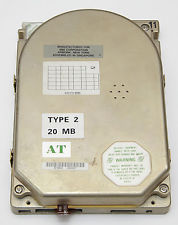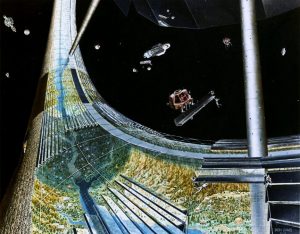Many years ago, when I used to build computers from found parts, installing hard drives was much more of an ordeal. You needed to look up the serial number of the  hard drive in a database—if you were lucky enough to find one—in order to locate the information you needed to type into the computer bios.
hard drive in a database—if you were lucky enough to find one—in order to locate the information you needed to type into the computer bios.
This sounds hopelessly clumsy now, when all you need to do is plug in the part and the system will recognize—out of the thousands of possibilities—the one you have. It was worse than clumsy. If you didn’t have access to the database, there was no way you could get the correct size, as well as the right amount of cylinders, heads, and sectors. Luckily for me, and for many other people, on the early internet there was such a database. Someone had laboriously typed in all of the data or, if he or she were lucky enough to have access to the spreadsheet, imported the data into a webpage and then set up a search engine so you could find your hard drive. At the time I was struck by the sheer altruism of that act. Like the people who edit Wikipedia, the person responsible for that crucial database is a saint.
I was contemplating buying a car in Toronto a few years ago and found one that was a good price. It was a  Toyota Echo, which I knew little enough about, but it had a major snag. The water pump needed to be replaced in order for the car to go anywhere without a tow truck. I had replaced a few on a Honda before, but I didn’t know if the Echo was easier or not. I turned to the internet—as many of us are doing these days—and found a man who had done the hours of work involved to show how to loosen the engine mounts, lift the engine, and get to the housing which would allow him to take out the water pump. What most amazed me was that he didn’t need to replace his when he made the video. He did that entirely for the edification of others.
Toyota Echo, which I knew little enough about, but it had a major snag. The water pump needed to be replaced in order for the car to go anywhere without a tow truck. I had replaced a few on a Honda before, but I didn’t know if the Echo was easier or not. I turned to the internet—as many of us are doing these days—and found a man who had done the hours of work involved to show how to loosen the engine mounts, lift the engine, and get to the housing which would allow him to take out the water pump. What most amazed me was that he didn’t need to replace his when he made the video. He did that entirely for the edification of others.
There are now many YouTubers running channels devoted to one obsession or another, and many of them are managing to make money off their page through advertising and the sale of merchandise. Out of those there are also many thousands who do not earn a dime off their hard work, as they, in relative obscurity, contribute to the largest archive of human effort in history.
Today, I was impressed by another instance of this altruistic contribution. I was working on a science fiction novel about a colonist on Mars and needed the formula for finding out the period of spin on two objects separated  by a kilometre of cable and needing a simulated gravity of .5 g. I found a page which had a JavaScript calculator built, it seemed, for that exact purpose. Although it was ostensibly meant to calculate such spinning objects and the resultant centrifugal gravity for space stations, and wasn’t meant for a science fictional voyage at .5 g, but the tool allowed modification of any of the four values. I could specify the gravity I needed, and then how much cable, and the script would find out the angular velocity and tangential velocity.
by a kilometre of cable and needing a simulated gravity of .5 g. I found a page which had a JavaScript calculator built, it seemed, for that exact purpose. Although it was ostensibly meant to calculate such spinning objects and the resultant centrifugal gravity for space stations, and wasn’t meant for a science fictional voyage at .5 g, but the tool allowed modification of any of the four values. I could specify the gravity I needed, and then how much cable, and the script would find out the angular velocity and tangential velocity.
When I was searching I found another similar page where someone takes on the sometimes frustrating task of educating people who are looking for answers and cannot be bothered to teach themselves. When one of the self-appointed instructors received a question which showed the person hadn’t thought about it very carefully, or perhaps did not have the education to understand an answer, the person who maintained the site was polite, thoughtful, thorough, explicit, and accurate.
Question – I am reading about space colonies and I saw some pictures of what it would be like inside  a cylinder shaped space station. There is land all around the inside, so if you were standing on land in it and looked up, you would be looking down on the people above you. How would the gravity work then and wouldn’t the gravity of the people above you pull you “up?”
a cylinder shaped space station. There is land all around the inside, so if you were standing on land in it and looked up, you would be looking down on the people above you. How would the gravity work then and wouldn’t the gravity of the people above you pull you “up?”
Answer – Lynn: As stated above, the method proposed for creating artificial gravity on a space station is to use a rotating system (like a rotating cylinder, torus, or sphere). Technically, rotation produces the same effect as gravity because it produces a force (called the centrifugal force) just like gravity produces a force. By adjusting certain parameters of a space station such as the radius and rotation rate, you can create a force on the outside walls that equals the force of gravity.
This is sort of like the amusement park ride where you get in a big cylinder with a lot of people and line up against the  walls. Then they spin the cylinder, producing a force that makes you feel pressed up against the sides. Everyone becomes glued to the walls of the chamber, and then they drop the floor out. No one falls to the ground because they are
walls. Then they spin the cylinder, producing a force that makes you feel pressed up against the sides. Everyone becomes glued to the walls of the chamber, and then they drop the floor out. No one falls to the ground because they are  being held to the edges by a force due to rotation. Another example would be swinging a bucket of water around over your head. The water doesn’t fall out if you spin the bucket around fast enough.
being held to the edges by a force due to rotation. Another example would be swinging a bucket of water around over your head. The water doesn’t fall out if you spin the bucket around fast enough.
In a rotating space station, people will be “stuck”  to the outside too, but with a force equal to that of gravity so they will be able to walk around on the edges. The force will be the same all around the outside of the rotating cylinder, so depending on the design it could look like people are living on the ceiling!
to the outside too, but with a force equal to that of gravity so they will be able to walk around on the edges. The force will be the same all around the outside of the rotating cylinder, so depending on the design it could look like people are living on the ceiling!
The gravity of people around you will not make any noticeable difference. It is true that all objects which have mass exert a gravitational pull on other objects, but unless the mass is very large (like the earth) it has little effect. The people on the space station will not change the artificial gravity on the space station just like they do not effect [sic] the gravity while they are on Earth.
Even as there are people with  guns trying to tear down the huge edifice that is human culture, I take comfort in the fact that there are many million others who are building it, contributing by laying one brick at a time.
guns trying to tear down the huge edifice that is human culture, I take comfort in the fact that there are many million others who are building it, contributing by laying one brick at a time.
